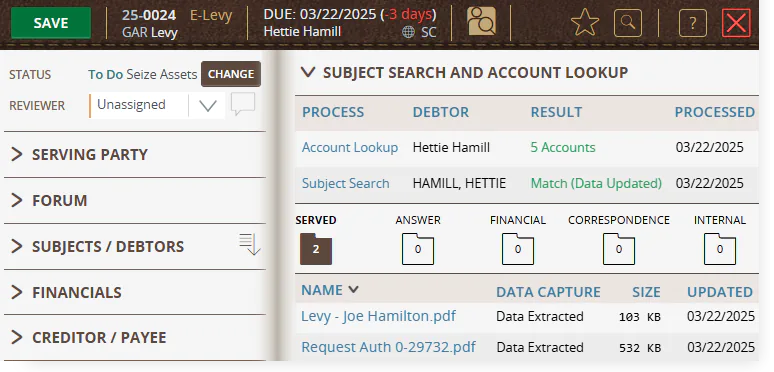Smarter Legal Order Processing
Safari automates legal order workflows, eliminating manual effort and ensuring accuracy. By enabling digital intake, integrating with customer systems, and automating communications and responses, Safari enables seamless, scalable workflows—reducing errors, accelerating response times, and enhancing compliance for levies, garnishments, and subpoenas.
Optimize Workflow Efficiency
Safari automates legal order processing for organizations handling high volumes of levies, court orders, and subpoenas. Our API-driven platform integrates with existing systems to streamline workflows, reducing manual effort, improving compliance, and enhancing efficiency.
For example, for levies and garnishments, financial institutions use Safari’s Subject Search integration to automatically determine whether a subpoenaed individual or debtor is a customer, using identifiers such as taxpayer ID or name. The Account Lookup integration retrieves account balances and ACH transactions to assess exempt and non-exempt funds, ensuring compliance with regulatory requirements. Additionally, Safari enables automated fund seizure, release, and account freezing, helping organizations efficiently enforce legal orders while reducing errors and maintaining an auditable history.
 SAFARI'S SUBJECT SEARCH INTEGRATION
SAFARI'S SUBJECT SEARCH INTEGRATIONAutomatically determine whether a subpoenaed individual or debtor is a customer, using identifiers such as taxpayer ID or name.
For subpoenas, our built-in delivery portal automates every step of the document delivery and cost recovery process. From secure transmission with two-factor authentication to automated invoice generation and real-time tracking, Safari ensures that response files are delivered efficiently and compliantly. The system also provides detailed reporting on portal access and payment activity, giving organizations full visibility into their subpoena response workflows in once centralized solution.
Eliminate Manual Work
Safari’s ServePort® digitizes and structures legal orders, turning unstructured documents into actionable data. This enables seamless, automated workflows from intake to resolution. The impact is significant: for example, financial institutions can achieve 50-60% “no-touch” levies, with Safari’s API integrations instantly determining if a debtor is a customer and has sufficient funds. If not, the system automatically generates a response—without human intervention.
If your team relies on spreadsheets or even a homegrown database, manual data entry is inevitable—leading to inefficiencies and duplicate effort. For example, sending an email often requires logging the action separately. With Safari, emails can be sent directly from the system using configurable templates, with every action automatically recorded in the audit history. The result? A streamlined, standardized workflow with no redundant data entry.
Improve Compliance
Compliance isn’t just a checkbox—it’s a critical part of handling legal orders accurately and securely. Safari embeds compliance safeguards into legal order workflows, ensuring that key regulatory checks are completed before organizations respond to subpoenas, levies, and court orders.
For example, our compliance functionality for levies and garnishments ensures that you track exemptions properly, and receive flags for complicated jurisdictional issues such as “restriction” state issuers.
For subpoenas, companies can track and flags disclosure restrictions, ensuring organizations do not mistakenly notify individuals when legal orders prohibit it. Financial institutions can enable RFPA compliance verification before releasing customer records, ensuring the proper certification has been received. Similarly, BSA compliance data can be automatically fed into FIU systems to ensure BSA compliance of tracking potential money laundering risks.
NEXT

